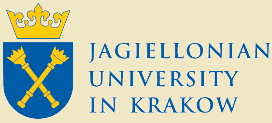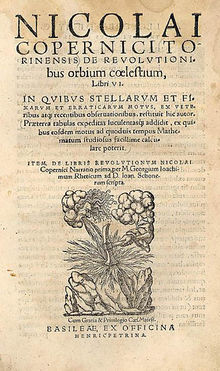Jagiellonian University
| Jagiellonian University | |
|---|---|
| Uniwersytet Jagielloński | |
 |
|
| Latin: Universitas Jagellonica Cracoviensis | |
| Motto | Plus ratio quam vis (Let reason prevail over force) |
| Established | 1364 |
| Type | Public |
| Rector | Professor Karol Musioł |
| Students | 49,379 (2010) |
| Undergraduates | 43,762 |
| Postgraduates | 3,212 |
| Doctoral students | 2,405 |
| Location | Kraków, Poland |
| Campus | urban |
| Affiliations | EUA, Coimbra Group, Europaeum, Utrecht Network, EAIE, IRUN |
| Website | http://www.uj.edu.pl/ |
 |
|
- For several academies alternatively called "Krakow Academy" or "Cracow University", see Education in Kraków.
The Jagiellonian University (Polish: Uniwersytet Jagielloński, often shortened to UJ; historical names: Latin: Studium Generale, University of Krakow, Kraków Academy, The Main Crown School, Main School of Kraków) was established in 1364 by Casimir III the Great in Kraków. It is the oldest university in Poland. It is the second oldest university in Central Europe and one of the oldest universities in the world.
In 1817 it was renamed Jagiellonian University to commemorate Poland's Jagiellonian dynasty, which had revived the University of Krakow after it had fallen upon hard times.[1] In 2006 The Times Higher Education Supplement ranked Jagiellonian University as the top Polish university.[2]
Contents |
History
Poland's King Casimir III realized that the nation needed a class of educated people, especially lawyers, who could codify the country's laws and administer the courts and offices. His efforts to found an institution of higher learning in Poland were rewarded when Pope Urban V granted him permission to open the University of Krakow. The Royal Charter of Foundation was issued on 12 May 1364, and a simultaneous document was issued by the City Council granting privileges to the Studium Generale. The King provided funding for one chair in liberal arts, two in Medicine, three in Canon Law and five in Roman Law, funded by a quarterly payment taken from the proceeds of the royal monopoly on the salt mines at Wieliczka.[3] Its development was stalled by the death of the king, and later the academy was re-established (1400) by King Wladislaus Jagiełło and his wife Jadwiga. The queen donated all of her personal jewelry to the university, allowing it to enroll 203 students. The faculties of astronomy, law and theology attracted eminent scholars: for example, Stanisław of Skarbimierz, Paweł Włodkowic, Jan of Głogów, and Albert Brudzewski, who from 1491 to 1495 was one of Nicolaus Copernicus's teachers. Jagiellonian University was the first university in Europe to establish independent chairs in Mathematics and Astronomy.
Throughout the history of the University, thousands of students from all over Poland, from Lithuania, Russia, Hungary, Bohemia, Germany and Spain have studied there. In the second half of the 15th century, over 40% of students came from countries other than the Kingdom of Poland. For several centuries, virtually the entire intellectual elite of Poland was educated at the University.
The first chancellor of the University was Piotr Wysz and the first professors were Czechs, Germans and Poles, many of them trained at the Charles University in Prague in Bohemia. Of the students attending about one third were Poles.
By 1520 Greek philology was introduced by Constanzo Claretti and Wenzel von Hirschberg; Hebrew was also taught.

The Golden era of the University of Krakow took place during the Polish Renaissance, between 1500 and 1535, when it was attended by 3215 students in the first decade of the 16th century. As the popularity declined, this record was not surpassed until the late 18th century.
In 1846, after the Kraków Uprising,[4] the city and its university became part of the Austrian Empire.
The threat of a closure of the University was dissipated in 1847 by the Austrian Emperor's decree to maintain it. Buildings, like the Collegium Novum opened in 1887, were added.
On November 6, 1939, 184 professors were arrested and deported to Sachsenhausen concentration camp during operation codenamed Sonderaktion Krakau. The university, along with the rest of Poland's higher and secondary education was shut down for the remainder of World War II.[5]
The faculty was also suppressed by the Communists in 1954.[5]
In 2007, the administrative offices including those of the Rector and Deans were located at the historic Collegium Novum.
Since 2000 a new complex of university buildings, the so-called Third Campus, is under construction, due for completion in 2010 (public funds earmarked for the project amount to PLN 946,5 mln, or EUR 240 mln).[6] The Third Campus borders the LifeScience Park managed by the Jagiellonian Centre of Innovation.
Notable people connected with the university



- Saint John Cantius 1390-1473. Scholastic; theologian
- Jan Długosz 1415-1480; historian
- Laurentius Corvinus 1465-1527; humanist; lecturer at the University
- Nicolaus Copernicus 1473-1543; astronomer; promoter of heliocentrism
- Francysk Skaryna 1485?-1540?; pioneer of the Belorussian language;first to print a book in an Eastern Slavic language (1517 in Prague)
- Andrzej Frycz Modrzewski 1503?-1572; diplomat; political thinker; religious thinker
- Marcin Kromer 1512-1589; historian; Prince-Bishop of Warmia
- Jan Kochanowski 1530-1584; Polish poet
- Bartosz Paprocki c.1543 - 1614; writer; historiographer; translator; poet; genealogist
- Stanisław Koniecpolski 1590?-1646; military commander; military politician; Grand Hetman of the Crown
- John III Sobieski 1629-1696; military leader; monarch of Polish-Lithuanian Commonwealth; victor of the Battle of Vienna
- Wincenty Pol 1807-1872; poet; geographer
- Ignacy Łukasiewicz 1822 - 1882; pharmacist; deviser of the first method of distilling kerosene from seep oil
- Carl Menger 1840-1921; economist; lawyer; founder of the Austrian School of economics
- Karol Olszewski 1846-1915; physicist; chemist; the first to liquefy oxygen, nitrogen and carbon dioxide from the atmosphere
- Wacław Sierpiński 1882-1969; mathematician
- Bronisław Malinowski 1884-1942; anthropologist
- Ivo Andric - Nobel laureate
- Henryk Sławik 1894-1944; diplomat; designater of a Righteous Among the Nations for the rescue of Jews in World War II Hungary
- Tadeusz Pankiewicz 1908-1993; pharmacist; Righteous Among the Nations who aided Jews in the Kraków Ghetto
- Józef Cyrankiewicz 1911-1989; communist politician; prime minister of Poland 1947-1970
- George Zarnecki 1915-2008; art historian specializing in English Romanesque art
- Antoni Kępiński 1918-1972; psychiatrist
- Pope John Paul II (Karol Wojtyła) 1920-2005
- Zbigniew Czajkowski ("Father of the Polish School of fencing") b. 1921
- Stanisław Lem 1921-2006; writer
- Bohdan Lepky; writer
- Wisława Szymborska b. 1923; poet; 1996 Nobel laureate in Literature
- Norman Davies b. 1939; British historian
- Krzysztof Zanussi b. 1939; film director
- Leo Sternbach 1908-2005; chemist; inventor of the benzodiazepine
- Paulo Szot born c. 1970; opera singer; Broadway musical theatre actor
- Bat-Erdeniin Batbayar born c. 1954 politician , political analyst and writer.
- Kazimierz Papée 1889 - 1979; Polish Ambassador to the Holy See 1939-1958
Outstanding professors
- Stanisław of Skarbimierz (1360–1431), rector, theologian, lawyer
- Paweł Włodkowic (1370–1435), lawyer, diplomat and politician, representative of Poland on the Council of Constance
- Albert Brudzewski (1445–1497), astronomer and mathematician
- Maciej Miechowita (1457–1523), historian, chronicler, geographer, medic
- Jan Brożek (1585–1652), mathematician, physician and astronomer
- Henryk Jordan (1842–1907), professor of obstetrics
- Walery Jaworski (1849–1924), gastroenterologist
- Władysław Natanson (1864–1937), physicist
- Stanisław Estreicher (1869–1939), founder of the Jagiellonian University Museum
- Tadeusz Estreicher (1871–1952), pioneer in cryogenics
- Marian Smoluchowski (1872–1917), pioneer of statistical physics
- Stanisław Kutrzeba (1876–1946), rector, General Secretary of the Polish Academy of Learning
- Andrzej Gawroński (1885–1927), founder of the Polish Oriental Society, master of Sanskrit
- Stanisław Kot (1885–1975), historian and politician
- Tadeusz Sulimirski (1898–1983), historian and archaeologist, experts on the ancient Sarmatians
- Stanislaw Smreczynskis(1899–1975) zoologist.
- Henryk Niewodniczański (1900–1968), physicist
- Bohdan Lepky, literature
Enrollment
The university has 52,445 students (including 1,612 degree students from abroad) and 3,657 academic staff (2008). About 1130 international non-degree students were enrolled in the year 2007. Programmes of study in 48 disciplines and 93 specialisations are offered[7]. The school has an exchange program with The Catholic University of America and its Columbus School of Law.[8] It also hosts a semester abroad program from University of Wisconsin - Steven's Point and the University of Guelph.
Library
The university's Jagiellonian Library (Biblioteka Jagiellońska) is one of the largest in the country, with almost 6.5 million volumes.[9] It has a large collection of medieval manuscripts [4], for example Copernicus' De Revolutionibus or Balthasar Behem Codex.
It also gathered the underground literature (so called drugi obieg or samizdat) from the period of communist rule (1945–1989).
Departments
The university is divided into 15 faculties:
- Law and Administration
- Medicine
- Pharmacy and Medical Analysis
- Health Care
- Philosophy
- History
- Philology
- Polish Language and Literature
- Physics, Astronomy and Applied Computer Science
- Mathematics and Computer Science
- Chemistry
- Biology and Earth Sciences
- Management and Social Communication
- International and Political Studies
- Biochemistry, Biophysics and Biotechnology
Student life

In 1851, the first student scientific association was founded. Now, over 70 student scientific associations exist at the Jagiellonian University. Usually, their purpose is to promote students' scientific achievements by organizing lecture sessions, science excursions, even international conferences for students like the International Workshop for Young Mathematicians, organized by the Zaremba Association of Mathematicians.
- University Study Oriented System (USOS)[10]
- Scientific Circles[11]
- Student Organizations[12]
- Ensembles[13]
See also
- Collegium Novum
- Collegium Maius
- Collegium Witkowski
- Jagiellonian Library
- Nawojka The legendary first female student from the 15th century
- Sonderaktion Krakau A German operation against professors and academics from the University of Kraków
Notes
- ↑ Jagiellonian University (homepage), "Calendar" [1].
- ↑ Times Higher Education Supplement (THES) "Jagiellonian University ranking among world universities". http://www.ui.ac.id/indonesia/extra/tabelqs.pdf. Retrieved 2007-09-11. Rank 287 worldwide as the first Polish university listed among the top 500 in 2006.
- ↑ Norman Davies, God's Playground; A History of Poland, Vol. I: The Origins to 1795, Columbia University Press, 1982, p.98.
- ↑ [2].
- ↑ 5.0 5.1 Weigel, George (2001). Witness of Hope - The Biography of Pope John Paul II. HarperCollins.
- ↑ "Campus of the Sixcentenary". http://www.kampus.uj.edu.pl/. Retrieved 2008-04-27.
- ↑ Newsletter, web: UJ-News35-PDF.
- ↑ [3].
- ↑ "Jagiellonian University: Cracow's Alma Mater", Warsaw Voice, 18 May 2008.
- ↑ University Study Oriented System (USOS)
- ↑ Scientific Circles
- ↑ Student Organizations
- ↑ Ensembles
External links
|
|||||
|
|||||
|
|||||
|
||||||||
|
|||||||||||||

